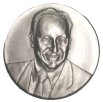
Basolo Award Presentation

 | Basolo Award Presentation | 
|
|---|

|
Joint Meeting of the Northwestern University Department of Chemistry and the Chicago ACS Section | 
|
|---|
| Speaker: |
Prof. Stephen J. Lippard
Head and Arthur Amos Noyes Professor Department of Chemistry Massachusetts Institute of Technology, Cambridge, MA |
|---|
| Topic: | Three Avenues in Bioinorganic Chemistry: Cisplatin, Methane Monoxygenase, and Metalloneurochemistry |
|---|
Date: Friday, October 18, 2002
Background information about the Basolo Award
NOTE: The Basolo Medal Lecture will be held at 4:30 P.M. - 5:45 P.M. at Northwestern University.
--- The Medalist Lecture is open to the public and admission is free to all those wishing to attend. ---
Northwestern University
Technological Institute
2145 Sheridan Road
Evanston, IL
Lecture Room 3
|
Biography:
Professor Lippard was born in Pittsburgh, PA, was an undergraduate at Haverford College (B.A., 1962) and completed his graduate work at M.I.T., receiving the Ph.D. in 1965. After a postdoctoral year as an NSF Fellow at M.I.T., he joined the faculty of Columbia University as an Assistant Professor in 1966, was appointed to Associate Professor with tenure in 1969 and to full Professor in 1972. He returned to M.I.T. as Professor of Chemistry in 1983, was appointed Arthur Amos Noyes Professor in 1989, and Head of the Chemistry Department in 1995. |
| Location of the dinner and general meeting: | Kendall College 2408 Orrington Ave Evanston, IL The Dining Room 847-866-1300 |
|---|
Presentation of the Basolo Medal and remarks: Susan Shih, Chair, Chicago Section American Chemical Society; Michael R. Wasielewski, Chairman, Chemistry Dept., Northwestern University; Prof. Stephen J. Lippard, 2002 Basolo Medalist, MIT, Cambridge, MA.
Reservations: (847) 647-8405, or by e-mail: chicagoacs@ameritech.net
by noon, Wednesday, October 9
or, REGISTER ON LINE !Please honor your reservations. We must pay for all dinners ordered. No-shows will be billed.
From the city: Take Lake Shore Drive North to Sheridan Road into Evanston. Continue on Sheridan Road to the Tech Institute. From the west: take I-88 east to 294 north to Dempster east. Proceed east on Dempster into Evanston. Turn left onto Chicago Ave. and proceed to Sheridan Road. Take Sheridan Road north to the Tech Institute. The Technological Institute is at the intersection of Sheridan Road and Noyes Street in Evanston.DIRECTIONS TO KENDALL COLLEGE:To those attending the Basolo Medal lecture, parking after 4:00 P.M. is available in the lot across from the Technological Institute at the corner of Noyes Street and Sheridan Road. Parking is also available on the side streets just west of this lot--however, observe the posted signs. Car-pooling is always encouraged.
Lecture room 3 is on the first floor of the Technological Institute and is most easily reached by entering through the main doors facing Sheridan Road. The lecture room is clearly marked and there will be signs at the entrance to guide you to the room.
Kendall College is located just a short walk (about 3 blocks) from the Tech Institute. If you are not attending the lecture and, instead, driving directly to Kendall College Culinary School, the following are directions from the Edens Expressway. Take the Edens to the Old Orchard Road exit. Proceed straight east to Green Bay Road and turn north two blocks to Central Street. Turn right onto Central Street and go two streets beyond Ridge Road to Orrington Avenue. Turn south onto Orrington Avenue 1.5 blocks. The culinary school has limited parking in the lot adjacent to the dining room. Parking is also available on the neighborhood side streets. Observe the posted signs.
This is the third year we have had the Basolo Medal dinner and presentation at Kendall College. Kendall College is the site of the premier culinary school in the Midwest, training chefs to work in the finest and most expensive restaurants. All those attending can look forward to a wonderful evening and a truly fine dining experience.6:00 p.m. - 7 p.m. Social Hour
Complementary wine, soft drinks, and hors d'oeuvres served butler style. Hors d'oeuvres selection: Salmon Canapes (Scottish salmon with chive spread and caviar), Shrimp Fritters (Battered rock shrimp with fresh ginger, corn, soy and cilantro and chutney), Lamb Tenderloin with mint yogurt and couscous, Spinach and Feta Cheese wrapped in a phyllo purse.
7 p.m. Dinner
The first course will be Pumpkin Soup (roasted pumpkin with allspice served with vanilla bean cream).
The second course will be a pear and walnut salad (poached pears and toasted walnuts served with mesclun greens, port wine vinaigrette, and blue cheese).
Assorted breads with butter, and beverage. Wine will be served throughout the evening.For the main course, choice of:
Lavender Chicken (Lavender honey-glazed chicken served with creamy goat cheese polenta and caramelized red onions and escarole).ORScaloppini of Grouper (Almond herb crusted grouper pan fried and served with mushroom risotto and tomato coulis).ORVegetarian free-form Pasta (Egg pasta layered with eggplant, portabella mushrooms, saute spinach, sun-dried tomatoes and ricotta cheese and tomato basil sauceDESSERTFruit Charlotte with raspberry sauce